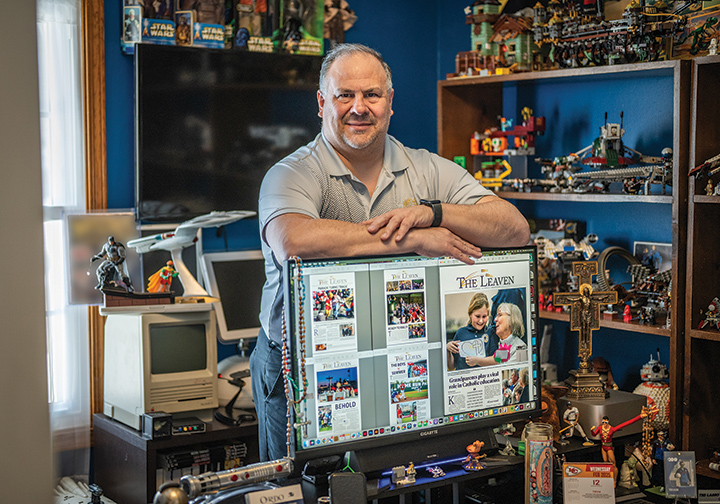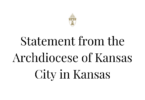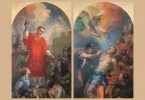
by Catherine Halbmaier
Special to The Leaven
KANSAS CITY, Kan. — In this era of visual dominance, eye-catching design is more important than ever. Especially for a print publication, readability is key.
Todd Habiger knows this better than most. Since 1994, Habiger has served as the creative mind behind The Leaven’s layout. In his decades on the job, he has mastered the dance of headlines, photographs and typography, choreographing them all into an arresting product.
“Good design gets newspapers noticed,” Habiger said. But his designs are meant to serve a singular purpose.
“You want people to ultimately read the words,” he added.
Meticulously crafted
Part of Habiger’s job is not only selecting which photos to use, but to implement them in ways that draw the reader in.
“We have excellent photographers and we always have,” Habiger said. “One of the reasons The Leaven has such good design is because we have even better photography. I try to choose the best photo that tells the story. Photography is a real complement to the story; they really go together. Both do their job.”

Despite the fact that everyone can now take up photography with the device in their pocket and easy graphic design tools are plentiful, it pays to have that professional eye.
“It’s definitely not as easy as it looks,” Habiger said. “When desktop publishing first became pretty prominent, the trouble was everybody wanted to use a thousand fronts on one little thing. You can also get too crazy with photos because you can use all these filters.
“In the end, I like the straight photo without a lot of bells and whistles. The power you have in your phone to take photos and do design is really awesome, but also sometimes the designs you get are really out there. It serves a purpose for certain things, but for newspapers and media in general, I like to stick to the traditional photo.”
He is just as careful in his choice of fonts.
“Typography is kind of a tricky thing because you notice it if it’s bad,” Habiger said. “I have taken a lot of care in choosing our typefaces and making sure they’re legible. I can look at [a font] on the computer, but I have to see it in print to see how it’s going to look.”

For readability, Habiger limits the paper to three or four fonts.
“Get more than that, and it starts to look kind of junky,” he said. “There needs to be consistency in those fonts. I want everything to go together.
“I really work hard to make The Leaven as reader-friendly as possible. I want people to pick up The Leaven and read every story from cover to cover. I do my best to make sure each story gets noticed, I want it to be read and I want people to enjoy it, to have fun, and ultimately learn and grow in their faith. That’s really what we’re all about, striving towards heaven.”
One of a kind
Christopher Gunty, associate publisher and CEO at the Catholic Review, lauds the readability of The Leaven, and attributes much of that to Habiger’s design.
“We can write all the wonderful words we want, but if people don’t see them and are not drawn into them, it’s like a cymbal with no clang,” Gunty said.
The paper’s layout is attractive and makes sense, he said.
“He makes the stories look good,” said Gunty. “The inside pages are good and the front page is attractive and brings you in. There are lots of features in the front, and the back is more boilerplate. The designer is saying he recognizes that the calendar doesn’t need a lot of attention; it is really features that make a difference.”
“Years ago, I used The Leaven in my newsroom as an example of what to do well,” Gunty continued. “An intentional photographer and intentional designer make a huge difference.”

Furthermore, the strength in The Leaven lies in its strong consideration of the local community, according to Gunty.
“We have to be intensely local,” Gunty said, “attracting and informing the readers. The Leaven does that really well.”
Gunty stressed the importance as well of having a print edition in today’s increasingly digital age.
“We did a survey in 2021 that led to our redesign, and 75 percent of people said they would read The [Catholic] Review less if it was only online,” Gunty said. “That led to an affirmation of the print product, and we get great response, reaching people in ways they wouldn’t reach otherwise. They may attend Mass more or give more than people who don’t read.”
“It’s the responsibility of the archdiocese to communicate these stories,” he continued. “Little stories — not just the most sensational ones. Local secular media isn’t going to tell those stories, not as well as we can tell it. That’s what we do — we can give that to them best.”
Total package
While Gunty makes a strong case for the importance of the reporting responsibilities of local print newspapers, Archbishop Joseph F. Naumann sees it serving an additional purpose as well.
“I see it as a tool for evangelization,” he said.

When he first came to the archdiocese from the Archdiocese of St. Louis, he was surprised at its tidy format.
“My initial reaction was it’s a lot smaller than the paper in St. Louis,” said the archbishop.
“I really have grown to appreciate it,” he continued, “because I think it’s much more readable than the paper in St. Louis, which was a good paper. I think our use of photography really helps to engage people and draws them in to actually read the stories.”
That packaging, he now knows, is primarily the work of Habiger. The fact that it is so intentionally designed makes the paper — even in this busy day and age — “readable.”
“It’s not that long,” he said. “I think the formatting is very well done. I think we’ve had excellent photographers, and those pictures draw people in. They want to know what this is about, so they read the article.
“So, I think, as a consequence, people read it more, and we can emphasize priorities. I’m amazed at how many people do read the paper pretty faithfully.”
“Particularly when the dominant secular press is very negative on the church and reports negatively on it, I think it’s really important that we have a publication that offers them a more accurate picture of the church,” the archbishop added.
He also noted that publications like The Leaven bring Catholics together, none of which would be possible without good design. “Even though so much of the life of the Catholic is lived in the parish, we’re not Congregationalists,” Archbishop Naumann said. “And so, we’re part of a bigger family, and I think The Leaven helps make them aware of that as well.”






